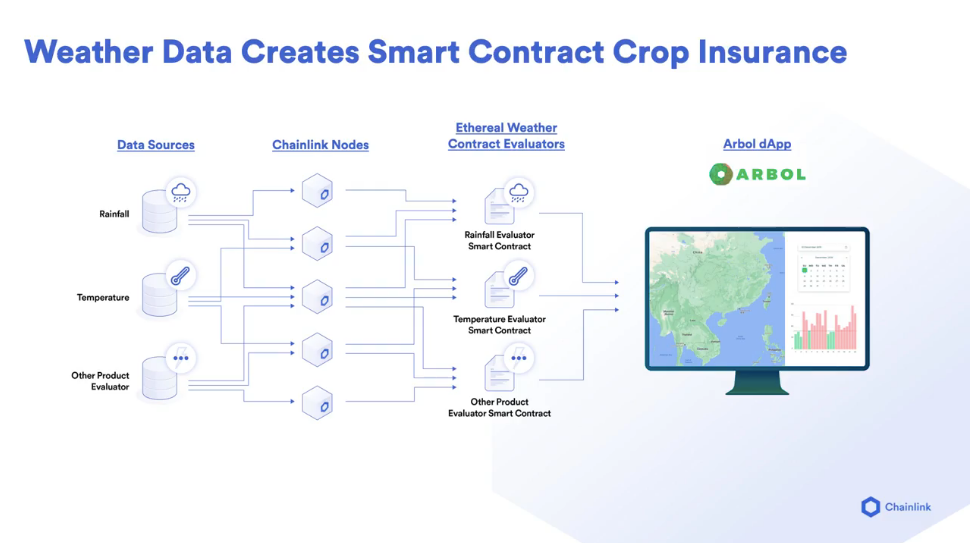Smart Contracts and Blockchain Can Help Close the Global Protection Gap, Enable Businesses to Build Climate Resilience
The great challenge of the upcoming century for enterprises and households will be how to proactively adapt and build resilience against changing and increasingly volatile and unpredictable weather patterns. For businesses that are exposed to weather and rely on a certain level of cooperation from the elements to operate normally, building climate resilience is a necessity for future success and survival. 70% of business globally are estimated to be impacted by weather, with damages from severe weather events and natural disasters rising each year. According to Aon, economic losses resulting from severe weather events totaled roughly $268 billion in 2020. Out of that total, only $97 billion in losses were insured, leaving a global protection gap of $171 billion.
As governments adapt to the impacts of climate change on businesses, military operations, and essential infrastructure, policymakers are also calling on financial institutions, corporations, and hedge funds to do more to identify, disclose, and mitigate climate risks and build institutional resilience. These risks are no longer an afterthought or a matter of future concern for global communities, even those in developed and wealthier nations. The U.S. Environmental Protection Agency (EPA) recently released a report showing the extent to which climate and weather events are adversely impacting communities throughout the U.S. EPA administrator Michael S. Regan said, “There is no small town, big city or rural community that is unaffected by the climate crisis. Americans are seeing and feeling the impacts up close, with increasing regularity.”
One of the most crucial investments that businesses will need to make to build climate resilience is weather insurance. While it is impossible to eliminate the physical toll that a natural catastrophe can take on a business (property damages, ruined crops, etc.), having a reliable insurance option in place can help mitigate the financial impact of these events, especially as they become more frequent and severe in certain communities. Weather insurance is a critical piece of financial infrastructure that nearly all entities with climate risks need. However, the issue today is simply that most weather/natural disasters are not covered by insurance. Millions of individual households and businesses are impacted by the widening global protection gap that exists, and that gap is even wider in developing countries and rural/geographically expansive regions where traditional insurance options that require a boots on the ground approach to verify losses and approve settlements are not feasible.
Using Blockchain and Smart Contracts to Expand Access to Insurance Products
Parametric insurance, which pays the end-user a predetermined settlement when a predetermined trigger (ex. rainfall, wind speeds) is met, is a viable and increasingly popular alternative to traditional insurance. Offering a farmer or business protection against excess rainfall by having a contract settle if it rains for more than half of their coverage period according to public, verifiable datasets from a source like the National Weather Service is one example of a parametric program that platforms like Arbol are already offering globally. Where the smart contract becomes important is in making sure that all of this is verified in a secure, trustless environment that makes the terms of the agreement transparent to all parties involved, and that automatically executes a settlement when a trusted oracle, like Chainlink, determines that the qualifying event has occurred.
Smart contracts built on the Ethereum blockchain, decentralized climate data from a network like dClimate, and Chainlink oracles make it possible for farmers and businesses in underserved regions and countries to access reliable insurance products. Because the smart contract settles automatically using global, tamper-proof datasets, settlements can be distributed rapidly anywhere in the world. Parametric insurance that leverages smart contracts and independent data not only makes coverage products more accessible to underserved clients, but ensures that disputes over settlements are eliminated.
Source: Chainlink
It is estimated that more than $1 trillion of crops globally are uninsured or underinsured. Insurance products and access to good, reliable climate data will be critical in a world where many businesses are just one catastrophic weather event (prolonged drought, excess rain) away from potentially losing everything. Platforms like Arbol, which utilize smart contracts and data to power a wide array of parametric weather protection programs ultimately aim not just to address the widening global protection gap, but to use innovative technologies like blockchain to make weather insurance products simpler, fairer, and more affordable.
About Siddhartha Jha:
Siddhartha Jha is the Founder of Arbol Inc. and currently serves as Chairman and CEO. Sid is also a founding partner of dClimate, the first decentralized network for climate data, forecasts, and models. Prior to Arbol and dClimate, he had over 13 years of experience in the financial industry covering the interest rates and commodities in both quantitative research and trading roles. He launched an agriculture futures trading portfolio, managing over $100 million at a major commodity trading firm. Sid was the first analyst at a startup commodity hedge fund, which grew to manage over $600 million in assets. He was Vice President of Interest Rates Strategy at J.P. Morgan.
Sid authored the well-received book “Interest Rate Markets”, published in both English and Mandarin. He has taught financial markets at NYU and was on the board of a non-profit working with inner city youth. Sid graduated from Harvard University with a B.A. Cum Laude in Applied Mathematics and M.A. in Statistics as part of a 4-year combined degree program.

